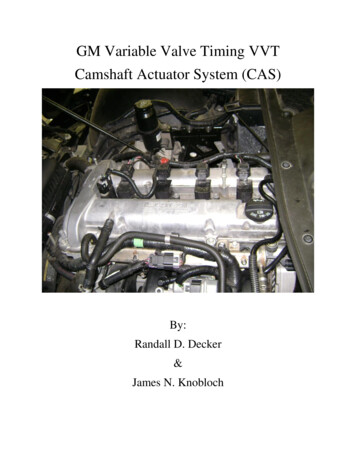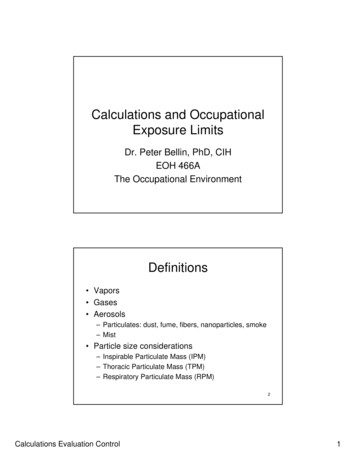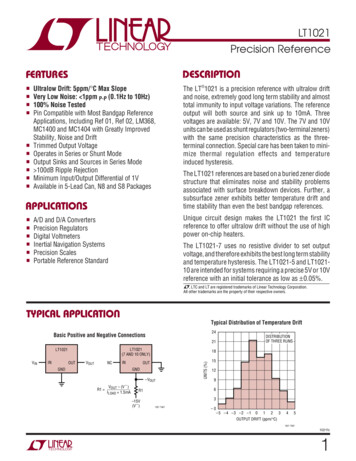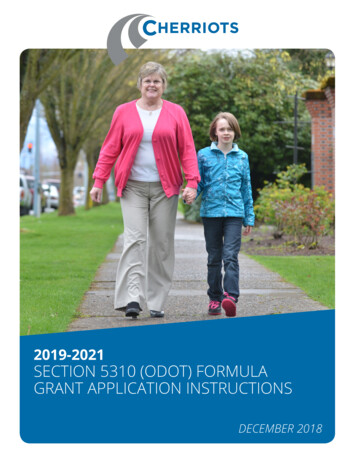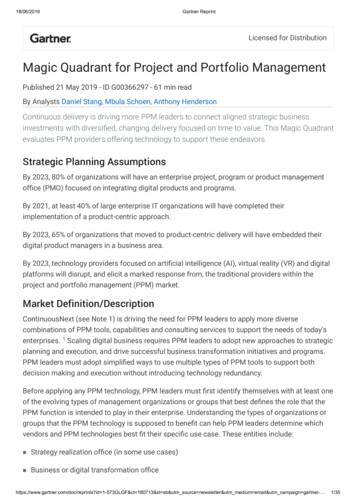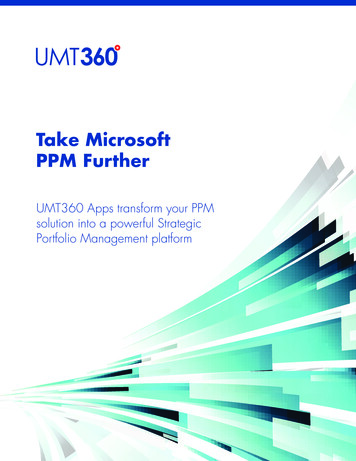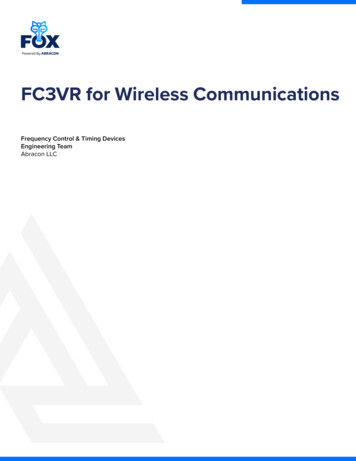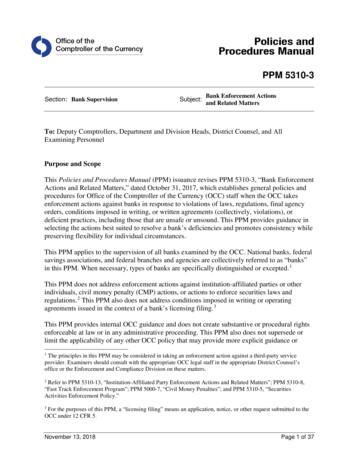
Transcription
PPM 5310-3Section: Bank SupervisionSubject:Bank Enforcement Actionsand Related MattersTo: Deputy Comptrollers, Department and Division Heads, District Counsel, and AllExamining PersonnelPurpose and ScopeThis Policies and Procedures Manual (PPM) issuance revises PPM 5310-3, “Bank EnforcementActions and Related Matters,” dated October 31, 2017, which establishes general policies andprocedures for Office of the Comptroller of the Currency (OCC) staff when the OCC takesenforcement actions against banks in response to violations of laws, regulations, final agencyorders, conditions imposed in writing, or written agreements (collectively, violations), ordeficient practices, including those that are unsafe or unsound. This PPM provides guidance inselecting the actions best suited to resolve a bank’s deficiencies and promotes consistency whilepreserving flexibility for individual circumstances.This PPM applies to the supervision of all banks examined by the OCC. National banks, federalsavings associations, and federal branches and agencies are collectively referred to as “banks”in this PPM. When necessary, types of banks are specifically distinguished or excepted. 1This PPM does not address enforcement actions against institution-affiliated parties or otherindividuals, civil money penalty (CMP) actions, or actions to enforce securities laws andregulations. 2 This PPM also does not address conditions imposed in writing or operatingagreements issued in the context of a bank’s licensing filing. 3This PPM provides internal OCC guidance and does not create substantive or procedural rightsenforceable at law or in any administrative proceeding. This PPM also does not supersede orlimit the applicability of any other OCC policy that may provide more explicit guidance or1The principles in this PPM may be considered in taking an enforcement action against a third-party serviceprovider. Examiners should consult with the appropriate OCC legal staff in the appropriate District Counsel’soffice or the Enforcement and Compliance Division on these matters.2Refer to PPM 5310-13, “Institution-Affiliated Party Enforcement Actions and Related Matters”; PPM 5310-8,“Fast Track Enforcement Program”; PPM 5000-7, “Civil Money Penalties”; and PPM 5310-5, “SecuritiesActivities Enforcement Policy.”3For the purposes of this PPM, a “licensing filing” means an application, notice, or other request submitted to theOCC under 12 CFR 5.November 13, 2018Page 1 of 37
PPM 5310-3establish supplemental procedures applicable to bank enforcement actions or treatment ofsupervisory or licensing issues arising from the various specialty areas (for example, consumerprotection, Bank Secrecy Act (BSA)/anti-money laundering (AML), asset management, orinformation technology).ContentsI.II.Introduction .3Types of Bank Enforcement Actions .4Informal Bank Enforcement Actions .4Formal Bank Enforcement Actions.5III.Determining the Appropriate Supervisory or Enforcement Response .61- and 2-Rated Banks .73-Rated Banks .74- and 5-Rated Banks .8Resolution .8IV.Decision Authority and OCC Legal Staff Responsibilities .8Supervision Review Committees .8OCC Legal Staff Responsibilities .9V.Formal Investigations .9VI.Content of Bank Enforcement Actions .10VII.Timeliness of Bank Enforcement Actions .11VIII.Follow-Up Activities .11IX.Assessing Compliance With Bank Enforcement Actions .12X.Communicating Bank Enforcement Action Compliance .13Bank Submissions and Requests .13XI.Terminating a Bank Enforcement Action .14XII.Documentation in OCC Supervisory Information Systems .15XIII.Public Disclosure of Bank Enforcement Actions .16Disclosures by Banks .16Appendix A: Informal Enforcement Actions Against Banks .18Appendix B: Formal Enforcement Actions Against Banks .20Appendix C: Bank Enforcement Action Processes and Time Frames .25Appendix D: Mandatory and Discretionary Provisions Under PCA .28Appendix E: Resolution .29Appendix F: Compliance With Enforcement Actions Page Template .31Appendix G: Sample Write-Ups for Compliance With Enforcement Actions Sectionof a Formal Written Communication .33Appendix H: Abbreviations .35Appendix I: References .36November 13, 2018Page 2 of 37
PPM 5310-3I.IntroductionThe OCC uses enforcement actions against banks to require a bank’s board of directors (board) 4and management to take timely actions to correct a bank’s deficient practices 5 or violations(collectively, deficiencies). Enforcement actions against banks are more severe than mattersrequiring attention (MRA). Violations, concerns in MRAs, or unsafe or unsound practices mayserve as the basis for an enforcement action against a bank.Deficient practices are practices or lack of practices that 6 deviate from sound governance, internal control, or risk management principles and havethe potential to adversely affect the bank’s condition, including financial performance orrisk profile, if not addressed, orresult in substantive noncompliance with laws or regulations, enforcement actions, orconditions imposed in writing in connection with the approval of any applications or otherrequests by banks.Clear communication between the OCC and a bank’s board and management is critical. TheOCC uses formal written communications, including reports of examination (ROE) andsupervisory letters, to document and communicate the OCC’s findings and conclusions from itssupervisory review of a bank. Formal written communications may contain concerns in MRAsor citations of violations requiring corrective action. The actions that the board and managementtake or agree to take in response to violations and concerns in MRAs are factors in the OCC’sdecision to pursue a bank enforcement action and the severity of that action. In some cases, itmay be appropriate for the OCC to pursue an enforcement action against a bank before theissuance of an examination’s formal written communication to require correction of significantdeficiencies as quickly as possible.A bank’s board and management must correct deficiencies in a timely manner. The OCCexpects a bank’s board to ensure compliance with bank enforcement actions within requiredtime frames by holding management accountable for the bank’s deficiencies.directing management to develop and implement corrective actions.approving necessary changes to the bank’s policies, processes, procedures, and controls.establishing processes to monitor progress and verify and validate the effectiveness ofmanagement’s corrective actions.The OCC’s policy is to identify deficient practices and violations in a timely manner and initiatebank enforcement actions to require corrective action well before deficiencies affect a bank’s4In the case of federal branches and agencies, the use of “board of directors and management” refers to federalbranch or agency management.5Practices include a bank’s policies, procedures, processes, and controls.6Refer to the “Bank Supervision Process” booklet of the Comptroller’s Handbook.November 13, 2018Page 3 of 37
PPM 5310-3financial condition or viability. The OCC’s short- and long-term strategy for a bank withdeficiencies is an important factor in determining the type of bank enforcement action(s) to use.The strategy considers the immediate actions needed to address the bank’s deficiencies andwhat actions might be needed in the future if the deficiencies develop into more seriousconcerns (for example, deficiencies threatening the bank’s viability). Although the primaryobjective of bank enforcement actions is remediation of a bank’s deficiencies, bank enforcementactions also can enhance the OCC’s position for timely and orderly resolution or receivership toprotect the Deposit Insurance Fund. The documentation of bank enforcement actions, a bank’sfailure to comply with those actions, and the consequences of that failure are importantcomponents of the supervisory record to support more severe subsequent bank enforcementactions when necessary.II.Types of Bank Enforcement ActionsEnforcement actions against banks can be either formal or informal. Enforcement actionsagainst banks do not include restrictions imposed by the OCC in response to a bank’s licensingfiling or by operation of law (for example, mandatory restrictions pursuant to prompt correctiveaction (PCA) or consequences of being in “troubled condition” under 12 CFR 5).Informal Bank Enforcement ActionsThe OCC typically first cites a violation or documents a concern in an MRA in a formal writtencommunication to address a bank’s deficiencies. 7 Examiners should consider an informal bankenforcement action when a bank’s condition is sound but deficiencies have not been correctedin a timely manner or escalation beyond the OCC’s citation of a violation or documentation of aconcern in an MRA is otherwise warranted. The board’s agreement or acceptance of an informalbank enforcement action can be indicative of its commitment to correct identified deficienciesbefore they adversely affect the bank’s condition. Informal bank enforcement actions aretypically not published or made available to the public.Informal bank enforcement actions include 7all nonpublic bank enforcement actions: Commitment letters. Memorandums of understanding (MOU). Individual minimum capital ratios (IMCR). Notices of deficiency issued under 12 CFR 30.operating agreements. 8Refer to the “Bank Supervision Process” booklet of the Comptroller’s Handbook for more information.8An operating agreement is a “written agreement” within the meaning of 12 USC 1818, which means that it isenforceable under 12 USC 1818. Only those operating agreements that do not relate to a bank’s licensing filing arebank enforcement actions. Operating agreements that are associated with or result from a bank’s licensing filing,while enforceable under 12 USC 1818, are not, however, bank enforcement actions for the purposes of this PPM.November 13, 2018Page 4 of 37
PPM 5310-3 conditions imposed in writing within the meaning of 12 USC 1818. 9Formal Bank Enforcement ActionsWhen a bank’s deficiencies are severe, uncorrected, repeat, unsafe or unsound, or negativelyaffect the bank’s condition, the OCC may use formal bank enforcement actions to support theagency’s supervisory objectives. Formal bank enforcement actions are typically published ormade available to the public and, with the exception of Gramm–Leach–Bliley Act (GLBA)agreements pursuant to 12 CFR 5.39 and formal agreements, formal bank enforcement actionsalso are enforceable through the federal court system. In addition, violations of a formal bankenforcement action can provide the legal basis for CMP assessments.Formal bank enforcement actions include all bank enforcement actions enforceable by the OCC in federal court: Consent orders and cease-and-desist (C&D) orders. Restitution orders (a type of consent or C&D order). Capital directives. PCA directives. Safety and soundness orders issued under 12 CFR 30.formal agreements.GLBA agreements pursuant to 12 CFR 5.39 (regarding financial subsidiaries of nationalbanks).CMPs (refer to PPM 5000-7).Refer to appendixes A and B of this PPM for more information regarding informal and formalbank enforcement actions and appendix D for a detailed discussion of the mandatory anddiscretionary provisions of PCA.Banks subject to certain formal bank enforcement actions (that is, C&D orders, consent orders,or formal agreements) are in “troubled condition,” as defined in 12 CFR 5.51, unless the OCCotherwise informs the bank in writing. 10 Banks in troubled condition must provide writtennotice to the OCC before adding or replacing directors or senior executive officers and aresubject to restrictions on golden parachute payments. 11 Consult with the appropriate OCC legalstaff in the appropriate District Counsel’s office (District Counsel) or the Bank Activities and9Only those conditions imposed in writing outside of an approval of a bank’s licensing filing are bank enforcementactions. Conditions imposed in an approval of a bank’s licensing filing are not bank enforcement actions and arenot within the scope of this PPM.10A bank is also in “troubled condition” if it has a composite rating of 4 or 5 under the Uniform FinancialInstitutions Rating System or is informed in writing by the OCC that, based on information pertaining to the bank,the bank has been designated in “troubled condition.” Refer to 12 CFR 5.51.11For more information, refer to 12 CFR 5.51, “Changes in Directors and Senior Executive Officers of a NationalBank or Federal Savings Association”; the “Changes in Directors and Senior Executive Officers” booklet of theComptroller’s Licensing Manual; and 12 CFR 359, “Golden Parachute and Indemnification Payments.”November 13, 2018Page 5 of 37
PPM 5310-3Structure Division for more information regarding the consequences of “troubled condition,”changes in directors or senior executive officers, or golden parachute payments.III.Determining the Appropriate Supervisory or Enforcement ResponseExaminers should consider the following factors when determining the appropriate response toa bank’s deficiencies. These factors do not represent an exhaustive list, and examiners mayconsider additional factors when warranted: The bank’s condition as reflected by its composite and component CAMELS/ITCC 12 orROCA 13 ratings.The bank’s risk profile, including trends.The nature, extent, and severity of the bank’s deficiencies.The extent of any unsafe or unsound practices.The board and management’s ability and willingness to correct deficiencies within anappropriate time frame.Potential adverse impact to bank customers, the Deposit Insurance Fund, or the public.The nature, extent, and severity of previously identified but uncorrected deficiencies.The bank’s progress in achieving compliance with any existing enforcement actions.The severity and direction of the bank’s deficiencies, ratings, and level of risk are crucial factorsto consider when deciding between an informal and formal bank enforcement action.Notwithstanding a bank’s composite CAMELS or ROCA rating, the bank’s financial condition,or the board and management’s ability or willingness, the OCC has a presumption in favor of aformal bank enforcement action when the bank exhibits significant deficiencies in its risk management systems, including policies,processes, and control systems.there is significant insider abuse.there are systemic or significant violations of laws or regulations.the board and management have disregarded, refused, or otherwise failed to correctpreviously identified deficiencies, including noncompliance with an existing enforcement action. failure to correct concerns communicated in MRAs. failure to correct violations of laws or regulations.the board and management have refused or failed to satisfactorily maintain the bank’s booksand records; have attempted to place unreasonable limitations on how, when, or where an12CAMELS integrates ratings from six component areas: capital adequacy, asset quality, management, earnings,liquidity, and sensitivity to market risk. ITCC ratings stand for information technology, trust, consumercompliance, and Community Reinvestment Act.13ROCA is the supervisory rating system for U.S. branches and agencies of foreign banking organizations andstands for risk management, operational controls, compliance, and asset quality.November 13, 2018Page 6 of 37
PPM 5310-3examination is conducted; or have imposed limits or restrictions on examiner access to thebank’s personnel, books, or records.While the presumption favors a formal bank enforcement action as described above, the OCCexercises judgment based on the totality of the conduct and circumstances.Pursuant to 12 USC 1818(s), the OCC is required to issue a C&D order in certain BSA cases.Refer to OCC Bulletin 2007-36, “Bank Secrecy Act/Anti-Money Laundering: BSAEnforcement Policy,” and OCC Bulletin 2016-6, “Bank Secrecy Act/Anti-Money Laundering:Process for Administrative Enforcement Actions Based on Noncompliance With BSACompliance Program Requirements or Repeat or Uncorrected BSA Compliance Problems.”When the bank fails to achieve compliance with an informal bank enforcement action, the OCCshould consider a formal bank enforcement action to address the outstanding deficiencies. Whenthe bank fails to achieve compliance with a formal bank enforcement action, examiners shouldconsider whether additional actions (for example, CMP assessments or other enforcementactions against the board or management or taking a more severe formal enforcement actionagainst the bank) are appropriate. Under certain rare circumstances, the supervisory office mayconsider replacing an existing bank enforcement action with a more focused or less severe bankenforcement action when the bank’s condition, risk profile, and nature of deficiencies warrant.Refer to the “Terminating a Bank Enforcement Action” section of this PPM for moreinformation.1- and 2-Rated BanksDeficiencies in a bank with a composite CAMELS or ROCA rating of 1 or 2 generally can beaddressed through the use of MRAs or citations of violations in a formal writtencommunication. A bank enforcement action may be warranted based on the severity ofdeficiencies or the board and management’s failure to address previously identified deficiencies.Enforcement actions against banks generally increase in scope and severity when the OCC haslow confidence in the board or management’s willingness or ability to correct deficiencies. Thedecision to recommend stronger bank enforcement action is the supervisory office’s 14responsibility, and the type of enforcement action should be based on the bank’s ratings, thedeficiencies’ severity, the level of risk, and the board and management’s ability and willingnessto correct the deficiencies within an appropriate time frame.3-Rated BanksThere is a presumption for use of a formal bank enforcement action for a 3-rated bank. Thepresumption is particularly strong when the bank is deteriorating because of declining trends in financial performance or anincreasing risk profile.14For purposes of this PPM, “supervisory office” refers to the examiner-in-charge, problem bank specialist,assistant deputy comptroller, director, associate deputy comptroller, or deputy comptroller, as appropriate,depending on the OCC business unit.November 13, 2018Page 7 of 37
PPM 5310-3 the bank has a less than satisfactory management component rating (3 or worse).there is uncertainty as to whether the board and management have the ability andwillingness to correct identified deficiencies within an appropriate time frame.4- and 5-Rated BanksWhile the board and management’s ability and willingness to correct deficiencies within anappropriate time frame is a factor in deciding the type of a bank enforcement action, the OCChas a presumption in favor of using a C&D order, a consent order, or a PCA directive, given thecondition and high-risk profile of composite 4- and 5-rated banks.ResolutionThe OCC has the authority to place a Federal Deposit Insurance Corporation (FDIC)-insuredbank into conservatorship or receivership when the bank is insolvent or has tangible equitycapital of 2 percent or less. Under certain circumstances, the OCC may initiate resolution byplacing a bank into receivership or conservatorship, or requiring its sale, merger, or liquidationbefore the bank becomes insolvent or has tangible equity capital of 2 percent or less. 15 Refer toappendix E of this PPM for more information on resolution options.IV.Decision Authority and OCC Legal Staff ResponsibilitiesThe Comptroller has delegated to the Major Matters Supervision Review Committee or to thesenior deputy comptrollers for bank supervision the primary responsibility to use the OCC’senforcement authority to accomplish the OCC’s supervisory and enforcement objectives. Incertain cases, senior deputy comptrollers re-delegate authority to initiate, negotiate, execute,modify, or terminate enforcement actions, including bank enforcement actions.Supervision Review CommitteesThe OCC has supervision review committees (SRC) that, among other things, review or makeenforcement decisions and promote consistent application of OCC policies. The supervisoryoffice and assigned OCC legal staff are typically responsible for presenting recommendationsregarding enforcement actions to the appropriate committee. 15Major Matters Supervision Review Committee (MMSRC): The MMSRC makesenforcement decisions on cases of heightened importance because of their visibility, policysensitivity, involvement of multiple agencies, nature of the issues, or potential systemicimpact.Washington Supervision Review Committee (WSRC): The WSRC reviews enforcementaction recommendations within its authority and serves as an advisory committee for theappropriate senior deputy comptroller who makes the final decision for his or her cases ordecides to refer the case to the MMSRC.Refer to 12 USC 1821(c)(5).November 13, 2018Page 8 of 37
PPM 5310-3 District or Midsize Supervision Review Committees (DSRC or MSRC): Each OCCdistrict office and the Midsize Bank Supervision division has an SRC that reviewssupervisory and enforcement action recommendations within its authority and serves as anadvisory committee for the appropriate deputy comptroller, who makes the final decision forhis or her cases or decides to refer the case to the WSRC or the MMSRC.OCC Legal Staff ResponsibilitiesThe OCC legal staff responsible for a case typically varies by the SRC review required orwhether the case involves litigation. Generally, District Counsel are primarily responsible forcases that require DSRC or MSRC review, while the Enforcement and Compliance Division(E&C) has responsibility for cases that require MMSRC or WSRC review or litigation. In mostcases, responsibility transfers as indicated in table 1.Table 1: Responsible OCC Legal Staff by Type of SRCType of bank matterResponsible OCC legal counsel (generally)MMSRCE&CWSRCE&CDSRC or MSRCDistrict CounselCase that begins with DSRC or MSRC, then goes tothe MMSRC or WSRC or otherwise involves litigationBegins with District Counsel, then transfers to E&C after referral to the MMSRC or WSRC, or before filing a notice of charges to commencelitigation.If District Counsel is primarily responsible for a case that may need to be presented to theMMSRC or WSRC by E&C or in which there is a likelihood of litigation, then District Counselshould promptly notify and consult E&C early in the process, well before any SRCconsideration.District Counsel and E&C also consult with specialized counsel in certain types of cases (e.g.,cases involving certain consumer laws, securities laws, or the Bank Secrecy Act) or whenotherwise appropriate.V.Formal InvestigationsIn most cases, documents and information may be obtained from the bank by the OCC pursuantto its examination authority. An order of investigation (OOI), however, may be appropriatewhen the OCC’s examination authority is not sufficient to obtain documents or otherinformation needed to accomplish OCC objectives, including determining whether (or to whatextent) there has been misconduct by or at a bank. 16 For example, an OOI is generallyappropriate when sworn testimony is needed, or when subpoenas are needed to obtain16OOIs are conducted pursuant to 12 USC 481 (national banks), 12 USC 1464(d) (federal savings associations),12 USC 1817(j), 12 USC 1818(n), 12 USC 1820(c), 12 USC 3102(b) (federal branches and agencies),12 USC 3108(a) and (b) (federal branches and agencies), 12 USC 3110 (federal branches and agencies),12 CFR 19.180–184 (national banks), and 12 CFR 112 (federal savings associations).November 13, 2018Page 9 of 37
PPM 5310-3documents from sources outside the bank. The OOI is a supplement to, and not a replacementfor, the OCC’s examination process.Pursuant to an OOI, the OCC may issue subpoenas to obtain documents and sworn testimony.The OCC may issue document subpoenas to institution-affiliated parties and to third parties(i.e., individuals and entities not directly affiliated with the bank). The OCC may also issuesubpoenas to obtain sworn testimony (under oath, transcribed by a court reporter) frominstitution-affiliated parties or other individuals, who may be subject to criminal penalties ifthey do not testify accurately and honestly. Pursuant to 12 CFR 19.181 (national banks) and 12CFR 112.3 (federal savings associations), information and documents obtained or used in theOOI are confidential (i.e., nonpublic OCC information).If the supervisory office determines that an OOI may be appropriate, it should consult withOCC legal staff. The supervisory office and OCC legal staff should consider the need for, scopeof, and resource requirements for any investigation. If the supervisory office and OCC legalstaff determine that there is a basis for initiating an OOI, the supervisory office (together withOCC legal staff) must obtain the necessary approval from the appropriate decision maker.Before opening an OOI that does not require presentation to the MMSRC or WSRC, the DistrictCounsel should consult with the Director of E&C to ensure proper coordination ofinvestigations.Upon the initiation of an OOI, OCC legal staff and the supervisory office should prepare aninvestigative plan. Investigations should be conducted with a clear supervisory objective and arealistic strategy for achieving that objective. Accordingly, OOI investigative plans must focuson specific issues, describe investigatory steps, include time frames for completion, and beupdated periodically as necessary. Investigations are often resource-intensive and requireongoing supervisory and legal attention. While the goal of investigations is to gain a completeunderstanding of the relevant conduct or transactions, investigations should nonetheless beconducted efficiently. Upon completion of an investigation, the supervisory office together withOCC legal staff must determine whether to recommend any enforcement action based on thefindings to the appropriate decision maker and proceed accordingly. Finally, upon completionof an investigation, the supervisory office together with legal staff must seek approval from theappropriate decision maker to terminate the OOI.VI.Content of Bank Enforcement ActionsBank enforcement actions must address deficiencies documented in a related formal writtencommunication or otherwise uncovered during an examination or investigation, as appropriate.Concerns in MRAs may be escalated into a bank enforcement action. Once the OCC determineswhich deficiencies must be addressed in the bank enforcement action, the enforcement actionmust identify the underlying basis for the enforcement action.specifically state any requirements placed on the bank and list any restrictions or limitationson the bank’s activities.November 13, 2018Page 10 of 37
PPM 5310-3 be explicit to guide the board’s or management’s corrective actions and facilitate OCCfollow-up activities.assign time frames by which the board or management must act, complete any correctiveactions, or be subject to restrictions or limitations on activities.Bank enforcement actions should generally be drafted using standard introduction, closing, andother language provided by the OCC’s Director for E&C, but they must be appropriatelytailored to address the specific deficiencies of the bank. Bank enforcement actions must bedrafted by or in consultation with OCC legal staff.VII.Timeliness of Bank Enforcement ActionsThe OCC’s policy is to take bank enforcement actions as soon as practical, including during anexamination if circumstances warrant. Whenever possible, the proposed enforcement actionshould be presented to t
Actions and Related Matters," dated October 31, 2017, which establishes general policies and procedures for Office of the Comptroller of the Currency (OCC) staff when the OCC takes enforcement actions against banks in response to violations of laws, regulations, final agency
